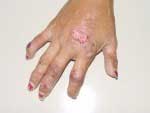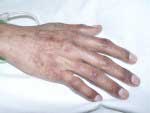Introduction
Many of the people who contact our centre for advice about their 'variegate porphyria ' (VP) turn out not to have the condition at all. These notes are intended to offer some advice about this problem of wrong diagnosis.
Symptoms and Signs of Variegate Porphyria
The skin

- easy blistering
- open sores
- scabs
- scars of lighter or darker skin colour
These are found only in sun-exposed areas; particularly the backs of the hands and also sometimes the face, forearms and neck. This is because the skin disease of porphyria is aggravated by sunlight. With time, the skin may become scarred with mottling in those areas.
False clues
Any other form of skin disease has nothing to do with porphyria. Thus, disease affecting parts of the body not exposed to the sun cannot be ascribed to porphyria. Nor can rashes, easy sunburn, or allergies.

The acute attack
The acute attack describes a special situation in which VP becomes biochemically more active. We can detect increased amounts of porphyrin precursors in the urine during such an attack. It is felt by the patient as abdominal pain, nausea and vomiting and is often accompanied by the passage of dark or even red urine. It is usually severe and comes in episodes. This means the patient will be free of pain for months or years and then have a short episode lasting several days, during which he or she is forced to go to bed and may require admission to a hospital.
False clues
The acute attack of porphyria is a very specific situation as outlined above. The following are not symptoms of porphyria.
- Pain which is felt day after day for months,
- colicky pain
- heartburn or indigestion
It must be stressed that the acute attack of porphyria is now rare. Many of those people who experience abdominal pain and claim that it is due to porphyria, are in fact experiencing nothing of the sort. Rather, they have one of the many other causes of abdominal pain such as irritable bowel syndrome.
Drug sensitivity in porphyria
Drugs can have only one deleterious effect in VP; they may induce the acute attack. Thus, a person with VP who takes a porphyrinogenic drug may develop severe abdominal pain, nausea, vomiting and red urine. This is almost always severe enough to require urgent treatment from a doctor.
False clues
For every person with porphyria who develops an acute attack in response to a drug, many people have bad reactions for other reasons. Thus, the following are no indication whatsoever of the presence of porphyria.
- Abdominal pain which is a recognised effect of a drug, such as heartburn after anti-inflammatories or aspirin and abdominal discomfort after tetracyclines
- Allergic reactions, particularly swelling of the face, rashes, or anaphylactic reactions with fainting and a drop in blood pressure
- An aggravated response to the usual action of the drug, e.g. a fall in blood pressure after taking medicines meant to reduce high blood pressure, or excessive sleeping after a tranquilliser, or being slow to wake up after an anaesthetic.
It must be stressed again that the only bad reaction of a porphyric to a dangerous drug is development of the acute attack, and not any of the situations outlined above (which are extremely common).
Summary
Thus, we find large numbers of people who have been told that they have porphyria because they have one, two or three of the following symptoms:
- any sort of skin problem,
- any sort of unexplained abdominal pain,
- any reaction to a drug.
These are totally inadequate grounds for making a diagnosis of porphyria unless each symptom clearly fits into one of the patterns described above.
Many normal people suffer abdominal pain at one time or another. Similarly, many people have one or other skin complaint. A fair number of people have both. Yet it is only a small group of people with abdominal pain, skin disease, or both who actually have VP, and their skin and abdominal symptoms will match those described above.
Adequate Testing for Porphyria
A diagnosis of variegate porphyria is only established after the CORRECT porphyrin tests have been performed, and you should read the pages on Diagnosis (Follow the menu on the left).
The only positive proof for a diagnosis of VP is:
- a positive plasma fluoresence scan
- a positive DNA test
- a positive chromatographic stool test meeting stringent criteria for positivity.
Your doctor should discuss your results with us if necessary.
Assessing Symptoms
That a person has VP does not prove that any symptoms they may experience are due to porphyria. It is essential to confirm biochemical expression of the porphyria by testing the urine for the levels of the precursors,ALA, PBG and porphyrins. Abdominal pain thought to be due to an acute attack must be confirmed by showing elevated PBG levels in the urine.